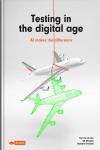“Testing in the digital age - AI makes a difference”
Digital is extending human possibilities, new ways of working, new thoughts and takes on existing products. Where new things are created, things are tried and tested. This is where testing of digital solutions comes into play. The common denominators with all digital terminology are:
- Speed: Extremely fast market response.
- Data: Huge amounts of data are collected.
- Integration: Everyone needs to integrate with everything.
Extremely high speed, huge amounts of data and an infinite amount of possibilities for integration are the elements we are facing for testing. They extend beyond our human capabilities.
One way to help us out is test automation. Test automation in the context of digital testing, is automating everything possible in order to speed up the complete product development cycle using all means possible means, even a robot taking over human test activities is a possibility. Further help can be found in combining it with another new technology not yet mentioned: Artificial Intelligence (AI). AI works with huge amount of data, finds smart ways through infinite possibilities and has to potential to hand us solutions quickly. Let us not forget that AI needs to be tested as well, but AI can make the difference here.
We can create robots that can do all the testing automatically and monitor data coming from the field. The robots also have to keep up with growing amounts of test cases, test data and test environments. Tests are executed on a system under test. In that sense it is a reactive (and time consuming in the release train) activity. Testing must keep up and shift from an executing activity, to a monitoring role, towards a quality forecasting medium that is ahead of the game.
The book provides insight into all aspects of testing digital solutions and includes the use of artificial intelligence or machine learning in testing, cooperation between robots and humans, to testing 3D printed products and autonomous machines. New building blocks, quality attributes and examples are discussed to help testers in this digital age. It helps users navigate the exponentially expanding amount of data and to make the right choices in the infinite amount of test possibilities now available.

